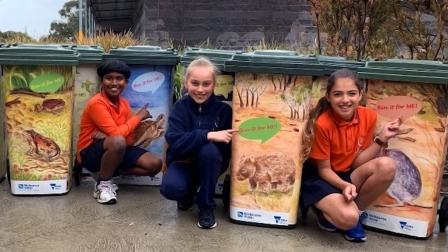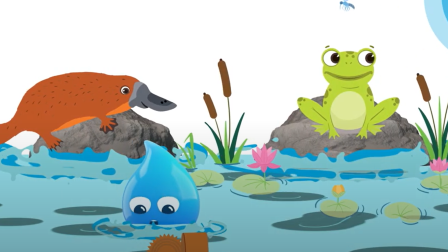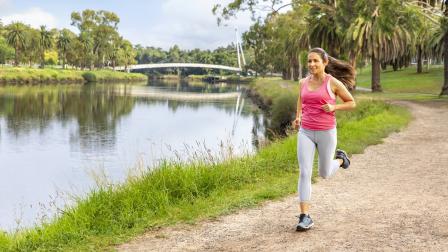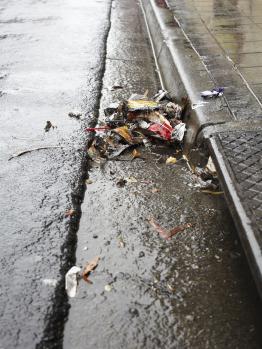Like you, we don't like seeing litter being washed off streets into stormwater drains and into our waterways.
Litter in our waterways harms our wildlife and ruins our enjoyment of these treasured open spaces. Rapid population growth and urbanisation is increasing litter reaching our beautiful waterways every day.
The most effective solution to litter management is preventing litter getting washed into our stormwater drains.
That’s why together with other groups, we take a collaborative approach to the way we tend for our waterways and manage litter. We work with councils, other agencies and the community to stop litter at the source and drive positive behaviours, as well as investing in litter clean up.
Across all 25,000km of Melbourne’s rivers, creeks and catchments, Melbourne Water spends approximately $1.6 million in litter management every year.
Everyone can make a difference to keep our waterways clean and healthy.
Understanding litter
Litter is the improper disposal of waste. It includes plastics, cigarette butts, food packaging, and general waste.
Litter pollutes our waterways, reducing the water quality of our rivers and creeks.
Aquatic animals, including the platypus, suffer from the negative consequences of litter. Injuries, suffocation, or starvation can result from litter and debris in the ecosystem they inhabit.
The litter journey
Litter dropped in suburban streets gets washed down stormwater drains by rain. Litter is the result of poor commercial or industrial waste management practices, irresponsible behaviour, carelessness and illegal dumping.
Did you know?
- More than 90% of litter found on Port Phillip Bay beaches comes from stormwater.
- Litter collected today could have been dropped over 10km away!
What is Stormwater?
Rainfall that runs off roofs, roads and other urban surfaces into gutters, drains, creeks and rivers, and eventually into the sea. This water can carry contaminants such as sediments, litter, oils, detergents, heavy metals, nutrients, pathogens and other toxicants.
Our role in litter management
Litter is a shared responsibility.
Councils, Melbourne Water and Parks Victoria are the principal agencies with the responsibility for removing litter from waterways and beaches. There is also a significant contribution from local community groups with environmental interests. Litter clean-up costs are significant for all principal agencies.
The Victorian Department of Energy, Environment and Climate Action (DEECA) plays a key role in setting policy direction, e.g. banning single use plastic and container deposit scheme.
The Environment Protection Authority Victoria (EPA) plays an important function to protect Victorians and the environment from litter. Under the Environment Protection Act 1970, littering is illegal. You can report litter and pollution at the EPA Victoria website. The EPA also uses a compliance approach to support businesses.
What we are doing to manage litter
In 2022-23, we contributed to the health of our waterways through direct maintenance works and capital works, including:
-
removal of litter from across 505 public open spaces
-
removal of 15,215 cubic metres of silt and 1220 cubic metres of litter and debris from Melbourne’s drainage system to protect water quality and prevent pollution in waterways.
-
maintained approximately 170 litter traps and other infrastructure to remove litter waterways
-
managed 63 outlets to the bay, and councils manage many more
-
spent approximately $1.6 million in litter management every year, across 25,000 km of Melbourne’s rivers, creeks and catchments
Working in collaboration
At Melbourne Water, we’re doing our bit: we're investing in projects to understand why littering occurs, where it comes from, how it is transported, what threats it poses to our waterways, as well as identifying the most effective solutions.
Since 2022, we complete a quarterly comprehensive Waterway Litter Condition Monitoring Survey for key catchments across our network. This information will be shared through Litterwatch by the end of 2024. This will assist and track litter reduction measures such as the Container Deposit Scheme and Catchment Litter Collaborations.
We have also developed a Framework for collaborations to address litter at the source. Here are the current projects we are working together with our partners:
- Lower Dandenong Creek Litter Action Plan
- Elster Creek Litter Collaboration
- Chain of Ponds Collaboration in the Moonee Ponds Creek Catchment
We also support the community to take Litter action: Make Litter Extinct. We also have created a number of key resources around litter and stormwater for schools aligned with the Victorian Curriculum called, The Story of Water: water and waterways.
Exploring future opportunities
Here are some ways we are exploring future litter initiatives:
- collaborating with RMIT University in the Aquatic Pollution Prevention Partnership
- trialling new smart technologies
- planning to install new litter traps in strategic locations including Huntingdale Wetlands Litter Trap
- supporting and leading catchment scale strategic investigations
- developing a litter prevention campaign toolkit
How international organisations manage litter
We continually explore innovative ways to manage stormwater and litter. It is important to note, we do face challenges different to other parts of the world. After rain the stormwater in our catchments travels very fast, making certain kinds of infrastructure such as bubble barriers or litter ‘socks’ unsuitable for many downstream locations.
Other kinds of infrastructure such as floating booms and gross pollutant traps need to be bypassed to avoid flooding if the rainfall is particularly intense. That places an even greater emphasis on working to prevent litter entering our drains in the first place.
Useful links
Strengthening our waste and recycling system (www.vic.gov.au)
Keep Australia Beautiful Victoria (kabvic.org.au)
You may also like...
Help make litter extinct
As Melbourne grows, the amount of litter does too. Together, let’s make litter extinct!

The Story of Water: Water and waterways
A network of stormwater pipes has been built across our cities to remove this excess water when it rains. Learn more.

Elster Creek Litter Collaboration
Melbourne Water is collaborating with Glen Eira City Council, Bayside City Council, City of Port Phillip, the Environment Protection Authority Victoria, and other partners to develop a holistic, data-driven approach to preventing litter entering Port Phillip Bay through Elster Creek.
Rivers and creeks
Rivers and creeks are central to everyday life, sustaining a complex ecosystem of plants and animals – and providing natural spaces for people to enjoy. Get to know some of Melbourne’s major waterways and the vital role they play.

Stormwater quality objectives
Stormwater quality treatment must be undertaken under the State Environment Protection Policies, which are binding for all government agencies, private individuals and businesses conducting activities on private and public land.
Gross pollutant traps
Gross pollutants traps are structures that use physical processes to trap solid waste such as litter and coarse sediment.

